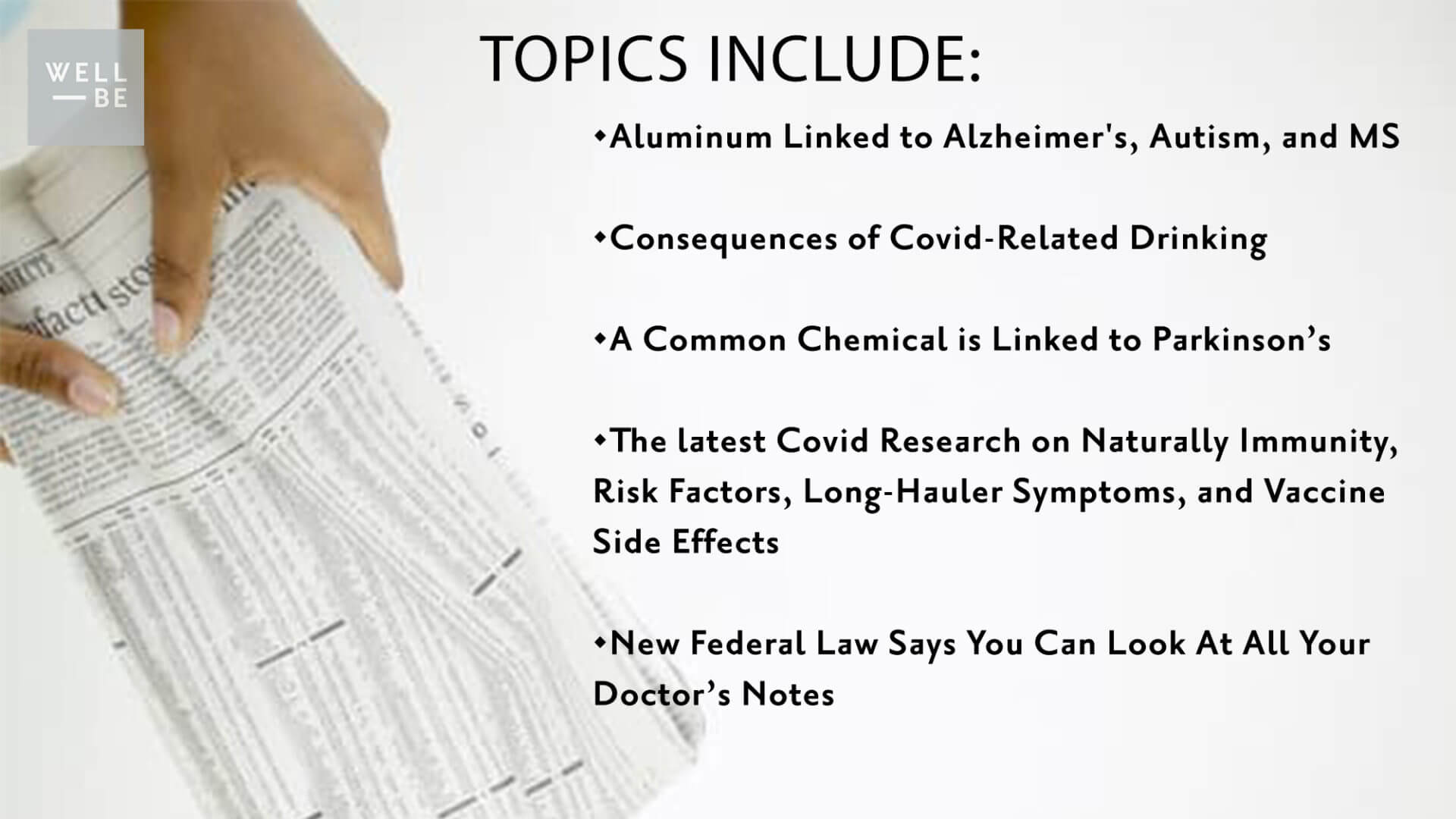Welcome to the second health research and wellness news wrap-up of 2021! While the pandemic is winding down for the most part, there’s still plenty of Covid-related news to cover — but it’s not all we’re talking about anymore. So this quarter, we’re bringing you a variety of different topics, both Covid and non-Covid, to help you stay informed about your health and that of your loved ones.
So without further ado, we present the 8 most important health and wellness news stories from April, May, and June of 2021 (click to skip to one):
- New Covid Risk Factors Found: Lack of Exercise, Poor Sleep, Low Testosterone & More
- Covid Long-Hauler Symptoms Continue to Pile Up, Especially Neurological Problems
- More Research Shows Strong Natural Immunity for Those Previously Infected with Covid
- Vaccine Concerns: Rare Side Effects, Breakthrough Cases, Vax for Kids, and Rushed Approvals
- Alzheimer’s News: Diet & Heavy Metal Affect Risk, Social Engagement Helps, and A Controversial New Drug
- Patient Advocacy News: Mammogram Debate, Preventable Hospital Readmissions, Best & Worst Lists, and Open Notes
- Toxins in Our Environment: Common Chemical Linked to Parkinson’s, Drinking Water Contamination & Three Encouraging Rulings
- Diet Matters: Processed Food & Heart Disease, Obesity & Cancer, Consequences of Covid-Induced Drinking
- Fitness News: Risks of Too Much HIIT, Exercise Boosts Memory, Plus Your Mom’s Activity Level While Pregnant Influences Your Fitness
1. New Covid Risk Factors Found: Lack of Exercise, Poor Sleep, Low Testosterone & More
What: A number of different reports and studies have identified more risk factors that increase a person’s risk of developing Covid-19 or experiencing a severe case of it. The new risk factors are: physical inactivity, lack of sleep and burnout, and low testosterone levels, as well as several conditions identified by the CDC, including type 1 diabetes, asthma, dementia, and cystic fibrosis.
The Details: In the exercise study, researchers looked at almost 50,000 adult patients who were diagnosed with Covid-19, comparing their disease progression with their level of physical activity. They found that patients who were consistently inactive (being active for fewer than 10 minutes per week) had a significantly greater risk of hospitalization, admission to the ICU, and death as compared to patients who consistently met activity guidelines (being active for more than 150 minutes per week).
Testosterone levels have also been found to impact Covid severity in male patients. In a relatively small study, researchers looked at 90 men and 62 women who were treated for Covid-19, and found that compared to men with moderate cases of the virus, median testosterone levels were 65% to 85% lower in men who had severe cases. Overall, 89% of the Covid-infected men showed testosterone levels that were lower than what’s considered the normal range.
Another study examined how lack of sleep and burnout impacted Covid risk, and found that both make it more likely for a person to contract Covid. Researchers looked at 2,844 frontline healthcare workers, and found that those experiencing work-related burnout were 2.6 times likelier to develop Covid-19 and to have a longer or more severe case. Because burnout and sleep are intimately connected, it’s probably not surprising that for each additional hour of sleep that a person got per night, their risk of developing the virus dropped by 12%.
Meanwhile, as we continue to learn more about the different ways the virus affects different people, the CDC has added several new medical conditions to the long list of pre-existing conditions associated with high Covid risk. The new conditions are: type 1 diabetes (type 2 was already on the list), asthma, liver disease, dementia, HIV, cystic fibrosis, stroke, and being even a little bit overweight (obesity was already on the list).
Why This Matters for Your Health & Our Takeaway: While masks, social distancing, and vaccines are all effective ways of reducing your risk of contracting Covid, or any virus, all of these new studies remind us that the number one way to protect your health is by keeping your body healthy. Living a healthy lifestyle filled with nourishing food, adequate exercise, and restorative sleep will keep chronic conditions at bay and allow you to more easily avoid acute conditions like Covid or any other medical issue.
______________________________________________________________________________
2. Covid Long-Hauler Symptoms Continue to Pile Up, Especially Neurological Problems
What: The studies keep pouring in with more information about the so-called “Covid long-haulers,” or people who recovered from the virus and then went on to develop more serious symptoms and complications in the months and weeks afterward. Covid long haul symptoms: Tinnitus & psychosis, depression, anxiety, irritability, brain fog, POTS, myalgic encephalomyelitis/chronic fatigue syndrome (ME/CFS) show these symptoms can be virus-induced. COVID-19 survivors face a sharply elevated risk of developing psychiatric or neurologic disorders in the six months after they contract the virus — a danger that mounts with symptom severity, new research shows. Eight in 10 patients hospitalized with COVID-19 develop neurologic complications, and these patients are much more likely to die in hospital compared with their counterparts without neurologic complications, a global study shows.
The Details: One study looked at the brain health of 236,379 Covid survivors, and found that one third of them were diagnosed with at least one of 14 psychiatric or neurologic disorders within 6 months of contracting the virus, with the rate increasing among those who were hospitalized or admitted to the ICU. The 14 conditions identified were: intracranial hemorrhage, stroke, Parkisons, Guillain-Barré syndrome, nerve disorders, muscle disease, encephalitis, dementia, psychotic/mood/anxiety disorders, substance abuse, and insomnia.
Another study looked specifically at various neurological issues, analyzing data from 3,744 patients hospitalized with Covid-19. The researchers found that 82% of them developed neurological problems, ranging from headache to loss of smell or taste to coma to brain damage. On top of that, the subjects who experienced neurological problems had a sixfold increased risk of death. Meanwhile, a study from a special Northwestern clinic for Covid-related neurological symptoms found that of 100 patients, 85 experienced four or more neurological issues, including brain fog, headaches, tingling, muscle pain, and dizziness. Five months after contracting the virus, most patients say they only felt an average of 64% recovered.
One less common but extremely concerning psychological issue is psychosis. While there have been only a small number of cases, instances have been documented worldwide, and the condition itself can be truly frightening. In this small group of adults with no previous history of mental illness, they develop symptoms of psychosis weeks after being infected with Covid. The way the psychosis manifests differs from person to person, with symptoms ranging from paranoia to violent tendencies and beyond, and some people recovering quickly while others need weeks of hospitalization and were prescribed medication.
Experts aren’t sure exactly why Covid causes such a wide range of brain-related problems, but they theorize that it has to do with an inflammatory reaction to the virus that can affect the brain along with the rest of the body. The range of different neurological and psychological symptoms makes sense, they believe, because the brain is a relatively small space, and so there’s a lot of overlap in regions responsible for different brain functions — meaning, a bit of inflammation in one place could cause a cascade of other issues.
But long-haulers aren’t only experiencing brain issues. A recent report found that of people struggling with ongoing symptoms like shortness of breath, cough, and abdominal pain, nearly a third of them had no symptoms when they were actually infected with the virus. Meanwhile, multiple case reports show that a relatively rare and often dismissed condition called postural orthostatic tachycardia syndrome (POTS) is also a symptom of long-haul Covid. POTS causes symptoms like lightheadedness, heart palpitations, dizziness, and fatigue, and has been found to be an after-affect of other infections as well, such as Lyme and Epstein-Barr.
And finally, many Covid long-haulers are now meeting the diagnostic criteria for myalgic encephalomyelitis/chronic fatigue syndrome (ME/CFS). The core criteria for an ME/CFS diagnosis include fatigue and malaise, poor sleep, cognitive impairment, painful allergies, and muscle aches. In an international study of 3,762 people suffering from long haul Covid symptoms, 78% reported fatigue and 55% reported brain fog.
Why This Matters for Your Health & Our Takeaway: Many of the above symptoms and conditions have long been doubted by the conventional medical community as being “real” like Chronic Fatigue Syndrome, or that psychosis or depression could be virus-induced. But this data on Covid long haul symptoms is solid evidence that many mental health, neurological, fatigue and pain-related conditions have a virus as a root cause. We hope this will change future diagnoses and treatment of these kinds of symptoms and conditions, rather than just masking symptoms with drugs, to testing and looking into potential viral (and other microbial) infections.
_______________________________________________________________________________
3. More Research Shows Strong Natural Immunity for Those Previously Infected with Covid
What: A deluge of new studies continue to strengthen the case that those who have been previously infected with Covid are protected from reinfection and remain protected for a while, even from variants, and that pregnant mothers with antibodies pass on protection to their babies.
The Details: We’ve known for a while that being infected with Covid provides some degree of protection, but it’s been unclear whether it confers as much protection as a vaccine. Two new studies suggest the answer is yes. One study looked at 52,238 healthcare workers and divided them into four groups: those who had previously been infected and weren’t vaccinated; those who had previously been infected and were vaccinated; those who hadn’t been previously infected and were vaccinated; and those who hadn’t been previously infected and weren’t vaccinated. They found that the rate of Covid infections remained near zero for every single group except those who had been neither infected nor vaccinated, suggesting that those who had contracted Covid previously but weren’t vaccinated had as much protection as those who had been vaccinated. Another large study out of Denmark found that prior infection with the coronavirus reduced chances of a reinfection by 80% in people under 65, and by about 50% in people over 65, and that this protection lasts for at least six months.
The question of how long this immunity lasts has been a big one, and a recent finding quiets concerns that immunity may be short-lived. Researchers had previously worried that the rate of antibodies dropped precipitously in the months after recovering from Covid (as is the case with the common cold), but two new studies have found that “memory cells” inside bone marrow last for a long time, and can churn out antibodies whenever they need to. One study found that about 80% of subjects had these so-called long-lived bone marrow plasma cells (BMPCs), which are a “persistent and essential” source of antibodies that remain even after the initial surge of antibodies declines. The other study found that not only do these BMPCs remain, they actually continue to mature and strengthen in the initial months after infection, supporting the notion that Covid immunity is long-lived.
Another question around natural immunity has to do with variants. If someone got infected with one form of Covid, are they protected against other variants? According to a new study, probably yes. The study looked at the T-cells in people who had previously contracted Covid, examining whether they could recognize the major Covid variants. Of the 45 identified genetic mutations of Covid, only one of them appeared able to escape T-cell recognition, suggesting that previously infected people don’t need to be concerned about the prevailing variants.
And finally, there’s the question of whether mothers pass on antibodies to their babies in utero, which also seems to be a yes. In the most recent study of 83 pregnant women, 72 of them passed antibodies across the placenta and into the umbilical cord, regardless of whether the mother was symptomatic. The takeaway from the study appears to be that these babies were born with natural protection from Covid.
Why This Matters for Your Health & Our Takeaway: The immune system is incredible. So much of what we talk about here at WellBe has to do with living in such a way that you allow your immune system to take the reins and do what it’s supposed to do. While nobody should run out and try to get infected with Covid, these findings underscore the power of natural immunity even when compared with vaccines that have an unprecedented protection rate.
_______________________________________________________________________________
4. Vaccine Concerns: Rare Side Effects, Breakthrough Cases, Vax for Kids, and Rushed Approvals
What: As vaccines continue to be administered worldwide, concerns continue to arise about potential rare but serious side effects, as well as rushed approval processes, especially for children’s vaccines.
The Details: Several new studies over the past few months bring to light some very rare but concerning side effects of the two common mRNA vaccines (Pfizer and Moderna). Cases of anaphylaxis have been reported since these vaccines began rolling out, and a new report has compiled the numbers to show how frequently they occur. According to the Vaccine Adverse Event Reporting System (VAERS), in December 2020 and January 2021, 9,943,247 Pfizer doses were administered, with 47 cases of anaphylaxis (0.00000473%), and 7,581,429 doses of the Moderna vaccine were administered, with 19 cases of anaphylaxis (0.00000251%).
A smaller study out of Israel has identified another potential side effect for patients who have autoimmune/inflammatory diseases: shingles. Looking at 491 patients with inflammatory issues (like rheumatoid arthritis), they found that they had a 1.2% rate of developing shingles after the vaccine, compared with 0/0% in the control group. This is notable because little is known about the safety or efficacy of the vaccine in immunosuppressed people, because they weren’t included in clinical trials.
Speaking of efficacy, there’s also some news on so-called breakthrough cases, or people who become infected after receiving the vaccine. According to the CDC, at the end of April, 101 million Americans had been vaccinated, with 10,262 reports of breakthrough infections (0.0001016%), over half of which came from the more concerning variants. The CDC says that these numbers show the vaccine is highly effective and working as expected, and have decided to stop investigating breakthrough cases unless a person becomes so sick that they’re hospitalized or die. It’s important to note that while these breakthrough numbers are quite low, they’re likely significantly underreported, and our understanding of the true numbers of breakthrough cases is nearly impossible now that the CDC has stopped investigating cases that don’t result in death or hospitalization.
Another subject of debate with regard to the vaccines has been how quickly they were rolled out. Amid the crippling pandemic, government agencies and private companies alike skipped or accelerated steps to get the vaccines out to the public, and now a group of doctors has petitioned the FDA to delay fully approving any Covid vaccines until all 3 phases of the clinical trials have been completed. The 27 petitioners call it “backward logic” to approve the vaccine in a rush in an effort to drive up vaccination rates, and say that the emergency authorization does enough to get necessary doses to the public. They say that all three phases of clinical trials are necessary, not only for efficacy but for safety, and that it is not within the FDA’s power to rush along scientific study in an effort to sway public opinion.
Doctors are also making their opinions known with regard to vaccinations for kids. The existing data shows that rates of infections among children are very low, with zero healthy American children dying of Covid to date. Moreover, there have been a few documented cases of myocarditis (swelling of the heart) in teen boys who have received the vaccine, adding an argument against getting a vaccine that appears not terribly necessary for young people. There are, of course, reasons why a parent might want their child to be vaccinated. For instance, children with comorbidities have died from Covid-19, so many doctors are encouraging kids with preexisting conditions to become vaccinated. There’s also multisystem inflammatory syndrome (MIS-C), a long-term side effect of Covid that’s afflicted 4,018 children who contracted Covid. However, as case numbers continue to drop, the risk of a child contracting Covid (already quite low) becomes even lower, and their risk of developing MIS-C falls near zero. There’s not a consensus among doctors about whether or not healthy kids should be vaccinated (though the WHO recently recommended against vaccinating kids unless they’re high risk), but the debate is happening, with some doctors saying yes, others saying no, and some suggesting that perhaps children may need only one dose of the two-shot vaccines.
Why This Matters for Your Health & Our Takeaway: The various Covid vaccines’ side effects, however rare, are real, and it’s important for people to be armed with all the information when they make their decision. If you have a pre-existing condition associated with vaccine side effects, or if you’re in a group that might not get any real benefit from the vaccine (like a healthy kid or someone who has natural immunity), you may want to do more research to determine if getting vaccinated is the best choice for you.
_______________________________________________________________________________
5. Alzheimer’s News: Diet & Heavy Metal Exposure Affect Risk, Social Engagement Helps, and A Controversial New Drug
What: A new study shows that eating a Mediterranean diet is associated with a lower risk of Alzheimer’s or dementia, while other studies tie early onset type 2 diabetes and aluminum exposure to higher risk. On the treatment front, structured social intervention has proved to be helpful at mitigating symptoms, while the FDA’s approval of the first new Alzheimer’s drug in decades is sparking outrage.
The Details: Previous studies had suggested that eating a Mediterranean diet might lower risk of cognitive impairment and early signs of Alzheimer’s disease, and a new study strengthens that assertion. In the study, researchers looked at data from 512 people with a mean age of 70, and gave them scores based on their adherence to the Mediterranean diet (eating fish, vegetables, fruits, nuts, legumes, and a moderate amount of wine, and avoiding meat and dairy). They then compared these scores with brain scans and tests, and found that those who adhered most closely to a Mediterranean diet had larger gray matter volume, better memory scores, and lower levels of biomarkers for Alzheimer’s.
Given the impact of diet on brain health, it’s perhaps not surprising that type 2 diabetes, often brought about by diet, can increase risk of Alzheimer’s disease and dementia. Some doctors and scientists are even calling dementia “type 3 diabetes.” New research on 10,095 adults found an association between the two conditions and, notably, found that the younger a person was when diagnosed with diabetes, the higher their risk of dementia. They found that a person’s risk of developing dementia increased by 24% with every five-year earlier increment of a type 2 diabetes diagnosis. A person diagnosed with type 2 diabetes between ages 55 to 59 had twice the risk of dementia in old age than a person in the same age group without diabetes.
Another confirmed contributor to Alzheimer’s and dementia risk: aluminum! A new study of 191 people has confirmed what had been previously speculated, that people with Alzheimer’s disease (as well as autism and MS) have significantly elevated levels of aluminum in their brains. More research is needed to understand the relationship between aluminum and these neurological and autoimmune conditions.
In terms of treatment, there’s new research being done on how structured social engagement in groups can improve cognitive function in people with Alzheimer’s or dementia. The Saint Louis University Aging and Memory Clinic is one of the institutions testing this approach, and have found that social interaction and group participation can improve memory and cognition in people with dementia. They’re one of several groups across the country testing this “social prescription” approach.
There’s also a more traditional prescription on the table now: in early June, the FDA approved the first new medication for Alzheimer’s disease in 18 years, aducanumab, which will go by the brand name Aduhelm. Since the approval, there’s been a ton of blowback, with many experts saying that there’s not yet enough evidence that it can help patients. In fact, a week after the approval, a high-profile watchdog group (Public Citizen) called for the removal of the FDA’s acting commissioner and two other top officials over the drug approval. They called the decision “reckless” and said it showed a “stunning disregard for science.” Aaron Kesselheim, MD, one of three FDA advisory committee members who resigned in the wake of the approval, agreed with Public Citizen that the agency’s credibility is suffering. “The aducanumab decision is the worst example yet of the FDA’s movement away from its high standards,” Kesselheim, a professor of medicine at Harvard Medical School, and Harvard colleague Jerry Avorn, MD, wrote in the New York Times on June 15. “Approving a drug that has such poor evidence that it works and causes such worrisome side effects is not the solution.”
Why This Matters for Your Health & Our Takeaway: About 6 million people in the U.S. and 30 million worldwide have Alzheimer’s, and it’s a sad and terrifying disease. These new pieces of research show the power we have to prevent the disease from ever taking hold, and that power lies — unsurprisingly — in living a healthy, non-toxic lifestyle. Avoiding toxins, eating healthfully, and staying socially engaged are the best things we can do to prevent cognitive issues in ourselves and loved ones. Learn more about eating for brain health in our interview with Max Lugavere.
________________________________________________________________________________
6. Patient Advocacy News: Mammogram Debate, Preventable Hospital Readmissions, Best & Worst Lists, and Open Notes
What: From studies to reports to legislation, a lot has been happening on the patient advocacy front. A new study found that hundreds of breast cancer centers tell women to get annual mammograms starting at age 40, going against federal guidelines, while another found that a startling proportion of readmissions after hospital procedures are avoidable. Plus, two new ranked lists came out, one with the best and worst hospitals based on the number of unnecessary surgeries, and another with the best and worst states for protecting patients from incompetent physicians. Finally, new legislation mandates that healthcare organizations give patients access to all clinical notes, test reports, and images.
The Details: A new study has reignited the long-simmering debate about at what age and how often women receive mammograms. Currently, the U.S. Preventive Services Task Force recommends women get mammograms every two years starting at age 50, but a recent study found that hundreds of breast centers tell women with no elevated risk to have a routine scan annually starting at age 40. The study says that these extra screenings could do more harm than good from a radiation exposure perspective, and suggest that the centers are recommending unnecessary screening for their own financial gain, a claim that the American College of Radiology calls “outrageous.” It’s notable that there’s currently no clear consensus on how frequently women should get mammograms, with the American Society of Breast Surgeons recommending annual screenings starting at age 40, the American Cancer Society endorsing yearly scans starting at 45 and then switching to every other year at 54, and the American College of Obstetricians and Gynecologists recommending screenings every two years starting at 40.
Another startling report showed that nearly 20% of postsurgical hospital readmissions are preventable, and cost the U.S. healthcare system nearly $300 million a year. Researchers looked at data from 1,937,354 patients, analyzing data from patients who were readmitted to the hospital within 30 and 90 days of undergoing nine different types of surgery, including various types of surgery involving the heart, digestive system, and joints. Their findings showed that 8.5% patients were readmitted within 90 days of surgery, and that 17.8% of these readmissions were potentially preventable. The study authors believe that comorbidities and socioeconomic factors might be at play here, and suggest that future readmissions could be prevented with sooner follow-up appointments and by ensuring patients have a plan and support in place to manage comorbidities.
Incompetent physicians pose a huge risk to patients (duh), and a new report from the consumer advocacy group Public Citizen shows which states are best at protecting the public from them. The report used disciplinary actions by medical boards as their benchmark for determining how well each state protects patients from doctors who jeopardize patients through incompetence, addictions, behavioral problems, or otherwise, and found that many states were doing “a dangerously lax job.” The worst states were Georgia, New Hampshire, and the District of Columbia, while the best were Kentucky, Arizona, and Pennsylvania. The report suggested that finances could be driving the lax discipline, as many medical boards get a lot of their funding from doctors’ licensing fees (so if more doctors lose their licenses, less money comes in).
Another ranked list came from the Lown Institute, naming the 50 worst and best hospitals in the country based on how frequently they performed procedures that are generally deemed to be unnecessary. They observed that in the worst hospitals, there appeared to be a culture of ignoring scientific evidence across different departments. The top hospital (meaning best for not performing unnecessary procedures) was Scott County Hospital in Kansas, followed closely by Beth Israel in Boston, while Hendry Regional Medical Center in Florida took the bottom spot.
And now for some good news: as of April 5, all healthcare organizations are required to provide patients with free, full, and immediate electronic access to all of their medical records. This includes doctors’ clinical notes, test results, reports from pathology, imaging, histories, progress notes, discharge summaries and more. The new law is part of the 21st Century Cures Act, a large piece of federal healthcare legislation.
Why This Matters for Your Health & Our Takeaway: The unfortunate reality of our healthcare system is that you really need to do your research and be your own advocate. While most doctors mean well, there’s a lot of misinformation, outdated practices, and financially motivated decisions that you need to actively protect yourself from. The confusing information about mammograms, startling stats about hospital readmissions are evidence of just that. Knowledge is your best protection against the dangers of our healthcare system, so we take every step toward transparency as a win, from the new “open notes” act to the lists of best and worst hospitals and states, all of which can equip people with more information to make the best choices that keep them healthy and avoid harm.
________________________________________________________________________________
7. Toxins in Our Environment: Common Chemical Linked to Parkinson’s, Drinking Water Contamination & Three Encouraging Rulings
What: It’s a good news/bad news situation on the toxic chemicals front. First, the bad news: recent research suggests that a common household chemical is behind the surge in Parkinson’s disease, while a nine-month investigation found that a huge proportion of drinking water in the United States is contaminated with known toxins. In good news, the EPA must now ban or closely regulate the use of chlorpyrifos on food, the EPA is banning sale of any menthol or other flavored tobacco products, and the Supreme Court has rejected an appeal from Johnson & Johnson’s to reverse a previous ruling requiring the company to pay billions in damages for selling their famous baby powder and other products that contained asbestos.
The Details: Parkinson’s disease — a serious degenerative disease of the nervous system — is the fastest-growing neurological disorder in the world, with the number of people afflicted in the U.S. increasing by 35% in the past 10 years, and experts predicting it will double in the next 25 years. While much about how and why Parkinson’s develops is still unknown, researchers are continuing to point to one common chemical as a likely cause. Trichloroethylene (TCE) is a chemical compound used in degreasing, dry cleaning, shoe polishes, and carpet cleaners, among other products, and studies have found a link between environmental exposure to TCE and Parkinson’s. In one study, researchers found that there was a sixfold increase in the risk of developing Parkinson’s in people exposed to TCE in the workplace. For some people, they’ll develop Parkinson’s shortly after exposure, but for others it may take decades, making it easy to dismiss TCE as a potential cause, but experts believe that the link is there.
In addition to worrying about the ingredients in your household cleaners, it’s also time to worry about your drinking water (sorry, not sorry!). A nine-month investigation by Consumer Reports analyzed drinking water across the U.S., testing water around the country for arsenic, lead, PFAS (per- and polyfluoroalkyl substances) and other contaminants. Taken together, the water systems they tested provided water to 19 million people. About 8% of the samples had levels of arsenic above Consumer Reports’ recommended maximum level for drinking water, and almost every sample had measurable amounts of lead, which is unsafe at any level. Almost every sample also tested positive for PFAS, which are linked to learning delays in children, cancer, and other health problems, with 35% of samples exceeding the safety threshold recommended by health experts. Arsenic gets into drinking water through industrial or agricultural pollution, lead leaches from corroding water lines and plumbing fixtures, and PFAS come from thousands of common household products — and while all three of them make their way into water sources, the EPA currently only has standards for arsenic and lead, which it seems aren’t always being met. It’s notable that this water contamination also highlights the issue of racial and class inequality with regard to health issues, as poor, rural, and Latino populations were much more likely to rely on water with high levels of harmful contaminants.
In a win for racial healthcare equality, the FDA announced in April that it will finally ban menthol cigarettes as well as all flavors of mass-produced cigars. As the last remaining flavored cigarette, menthols often serve as an entry point to cigarette addiction, and they’re mostly smoked by and aggressively marketed to Black Americans. About 480,000 Americans die each year from smoking-related diseases, and a disproportionate amount of these people are Black smokers. According to one study, the ban on menthol cigarettes could potentially save 633,000 lives by 2050. In their announcement, the FDA said they would put forth standards to enforce the menthol ban by the end of the year.
On the very same day as the FDA’s announcement, a federal appeals court ruled that the EPA must ban all uses of the insecticide chlorpyrifos on food or establish new residue levels that are safe for children within 60 days. Chlorpyrifos is known to have neurotoxic effects on children and farmworkers, and activist groups have been pressuring the EPA for over a decade to ban it. In fact, there was a proposed ban in 2016, but it was then reversed under the Trump administration. However, the recent ruling is likely to finally put the debate over the insecticide to rest and keep it out of our agricultural system for good.
Meanwhile, another ruling came down on the side of protecting consumers when the Supreme Court rejected an appeal from Johnson & Johnson seeking to undo a $2.1 billion damages award against it. The damages are in response to allegations that the company knowingly sold asbestos-containing talc powder products, which caused women to develop ovarian cancer. The Supreme Court said that it would not hear the case, letting the previous ruling stand.
Why This Matters for Your Health & Our Takeaway: Keeping toxins out of your body is one of the pillars of staying healthy and preventing chronic disease — but sometimes it can feel like a full-time job! It’s heartening to see that courts are taking steps to protect consumers in certain instances, but the news on TCE and water contaminants is a reminder to stay vigilant. Make sure you only drink filtered water from a water filter that’s best for the contaminants in your area, and consult our Non-Toxic Product Database to keep TCE and other harmful chemicals out of your house and off your body!
________________________________________________________________________________
8. Diet Matters: Processed Food & Heart Disease, Obesity & Cancer, Consequences of Covid-Induced Drinking
What: Three new pieces of research show how what we put in our mouth directly impacts our health outcomes, with one study drawing a direct connection between processed food and cardiovascular disease and another showing that obesity-related cancers are on the rise. Meanwhile, data from the past several years shows that increased drinking during Covid has led to an uptick in alcohol-related diseases.
The Details: Eating processed foods can have a whole host of negative health repercussions, from weight gain to poor gut health to skin issues, and a new study has added heart disease to the list. Researchers looked at a sample of 3,003 adults, comparing their diet with their cardiovascular health over a period of 17 years, and found that consumption of more ultra-processed foods corresponded with a greater risk of cardiovascular disease and death. Each additional daily serving of processed foods — things like bread, meat, and soft drinks — was associated with worse outcomes, even after adjusting for other cardiovascular risk factors.
Of course, another potential consequence of eating heavily processed foods is obesity, which comes with its own serious health issues. One of those health issues? Cancer. A new study used CDC data to look at 20-year mortality trends for cancer in the United States, separating out obesity-associated cancers (such as cancers of the liver, pancreas, colon, and kidney) and cancers not associated with obesity. They found that in the years between 1999 and 2011, deaths from obesity-associated cancers per 100,000 people declined from 66.5 to 58.2, but by 2018, that number had only dropped to 54.9, showing a significantly slowed rate of decline. When it came to cancers not associated with obesity, the rate of decline continued to increase during the same period. These findings are particularly sobering given that the prevalence of obesity has tripled during the past 50 years, about 40% of all Americans over 20 are classified as obese, and 71.6% of Americans over 20 are overweight or obese. Let that sink in!
Another negative trend in the U.S.? Excessive drinking. Likely brought on by the isolation, stress, and lack of structure of the Covid pandemic, many people developed unhealthy drinking habits in the past year — and doctors are seeing the fallout. According to recently released data, inpatient consults for alcohol-related GI and liver diseases surged shortly after the beginning of the pandemic, and have remained elevated. What’s more, the severity of these health issues also worsened, as measured by the proportion of patients needing endoscopic interventions. Researchers looked at data from the largest healthcare organization in Rhode Island, comparing 2020 numbers to 2019. They found that during the first lockdown in the spring of 2020, the total number of GI consults declined by 27% — but the proportion of those consults for alcohol-related issues increased sharply by 59.6%. After the first reopening in the summer of 2020, the overall rate of consults was restored to 101%, but the proportion of consults for alcohol-related conditions remained elevated by 78.7%. Another scary detail? As the pandemic wore on, the median age of people seeking help for alcohol-related issues became younger, moving from 56 to 51.
Why This Matters for Your Health & Our Takeaway: What you put in your mouth is, hands down, the biggest determinant of your overall health. These three studies simply underscore that fact, reminding us how deeply important it is to eat a whole-food-based unprocessed diet, maintain a normal weight, and to drink mindfully and in moderation when we drink. That doesn’t mean you can’t ever have a cookie or a cocktail on a special occasion — it just means that you treat your body with the respect and care it needs to live a long, healthy life. And since ultra-processed foods provide 58% of daily calories in the average U.S. diet, it means you probably have some friends or family putting themselves at risk for cardiovascular disease.
_______________________________________________________________________________
9. Fitness News: Risks of Too Much HIIT, Exercise Boosts Memory, Plus Your Mom’s Activity Level While Pregnant Influence Your Fitness
What: Tons of interesting exercise news this quarter, both in terms of what works and what doesn’t, and the uncontrollable factors that shape your own personal fitness. Research shows that doing too much high intensity interval training (HIIT) can actually hurt the function of your cells, while another study found an association between exercise and improved memory. Meanwhile, another study found that a mother’s exercise habits while pregnant could determine their child’s health later in life.
The Details: Many studies have associated high-intensity interval training (HIIT) with various health benefits, including increasing the number of mitochondria in our muscle cells, which can contribute to better metabolic and cellular health. But a new study set out to see if that means that more HIIT means more benefits, and the answer seems to be no. Researchers studied 11 healthy adults over the course of four weeks, having them perform two sessions of HIIT the first week, three sessions the second week, five sessions the third week, and then recovering with shorter and lower intensity activity the fourth week. Each week, the researchers biopsied the participants’ leg muscles and tested their blood sugar control. From week one to week two, their mitochondrial function and blood sugar control increased, but in week three, things went awry, with mitochondria function decreasing and blood sugar going through tumultuous swings. During the recovery week, things started to return to normal, but not fully. The researchers’ takeaway is that HIIT can be useful, but only in moderation.
Moving from physical to mental fitness, another study looked at how aerobic exercise impacts cognition. Researchers recruited 30 participants, all older than 60, and divided them into two groups: one that did aerobic exercise for 12 months, another that did stretching exercises for 12 months. By the end of the year, they found that those in the exercise group had shown 47% improvements in memory scores, compared to minimal change in the stretching group. Brain scans showed that, for those who did aerobic exercise, there was increased blood flow to two regions of the brain that are important for memory, revealing more clearly the relationship between exercise and cognitive function.
Think your fitness level is just about you? ? How much your mom worked out while she was pregnant may actually play a role. In a recent study of mice, researchers allowed one group of mice to eat a high-fat, high-calorie diet, resulting in obesity and metabolic problems, while keeping a control group of normal weight mice. Then, they paired up the mice into couples to mate, with one obese mouse and one normal-weight mouse in each, and several pairs of normal-weight mice producing control offspring. During the mice’s pregnancy, some mothers (both obese and normal-weight) jogged on little hamster wheels. After the baby mice were born, they were all fed the same diet from birth through adulthood. Upon achieving adulthood however, many of the offspring of obese parents developed obesity, insulin resistance, and other metabolic problems. However, if the mother mouse ran on the treadmill while pregnant, their children showed almost no metabolic issues as adults, regardless of whether either of their parents were obese.
Why This Matters for Your Health & Our Takeaway: It feels we cover the importance of exercise in almost every wrap-up — but that’s because new pieces of research continue to come out showing just how important it is! These new pieces of research shed new light on the nuances of different types and quantities of exercise, but the takeaway remains that staying active is essential for your health and the health of any future kiddos. We know, getting regular exercise can feel like a chore (in fact, another recent study looking at grizzly bears showed that bears are just as naturally lazy as humans: they’ll always choose the easiest route across a landscape and will prefer to move more slowly whenever possible!), but it’s an important one. The key is, based on the grizzly bear study findings, to exercise in a way that doesn’t feel like exercise so your brain won’t try to take the path of least resistance or resist doing it. Combine it with fun and play (sports with friends, dancing to a great playlist, seeing a beautiful view at the top of a hike or wandering all day through a new city). Or just set your life up so you have to stand up and move frequently (again to outsmart your body’s natural, biological inclination to move as little as possible).
Other News Worth Noting:









Thank you for these latest articles. Very informative!